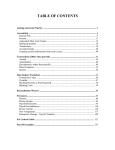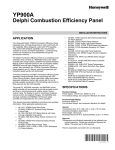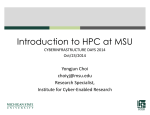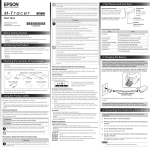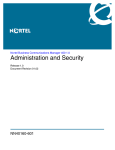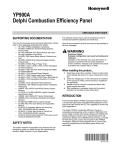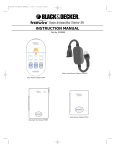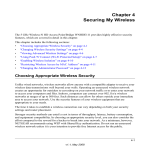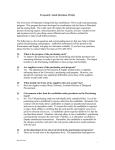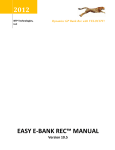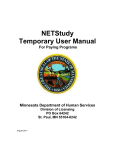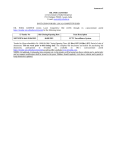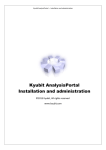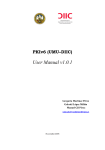Download Priority Software® BA3: User`s Manual
Transcript
1 Priority Software® BA3: User’s Manual Getting started in Priority: • Locate the Priority icon on your desktop and double-click to open: • When the log-in screen pops up, enter your log-in name and password, then click “OK” • A “Tip of the Day” window will pop up. Click on “Previous Tip” or “Next Tip” to see more tips, or just click “OK” to continue You have now opened Priority! Priority Software BA3.LNK 2 This screen will appear with top news and information: At the lower part of the screen, you will at times see a red, yellow, or green symbol: • Red means you cannot enter any new data until a new patch has been uploaded into Priority. This requires notifying IT that they must put in the new software update before any new additions can be made. • Yellow means that there have been some software changes. They should be included in the system, and they won’t affect any new data that will be entered. • Green means the system is available and ready. Please continue. 3 There are 7 major areas in Priority: 1. 2. 3. 4. 5. 6. 7. Accounting Donations NCI Personnel Publications Maintenance User They are listed on the left menu: 1. 2. 3. 4. 5. 6. 7. Note: You will be dealing only with 1. Accounting and 4. Personnel. The other areas are not in use at the University of Maryland. 4 To get started, you will want to set up accounts and add persons. The following pages will provide instructions on how to do these things. • Under both Accounting and Personnel, you will find the options “Forms” and “Reports.” Click on either one to display these options: • Forms are used to enter new data into the system. You will go here to add accounts, add persons, do encumbrances, edit saved information, and do other things requiring data entry. Click on “Forms” to display the different forms you can use • Reports are used when you want to view data that have already been entered into the system. When you are in Reports, you cannot enter new information into the system. Click on “Reports” to display the different reports you can view 5 ACCOUNTING Adding accounts: • Click on “Forms” from the left menu under Accounting: • Locate the Accounting menu and click on the first item: “Account Information” 6 • A window will pop up. The data you will find on this form is set up from an FRS download, so it is taken directly from FRS. The account information is similar to the information contained in the FRS account header. • Before entering any information into this form, you will need to search the system for existing data pertaining to the account you want to add. To search for existing data, click on the “Filters” tab: • Filters is Priority’s search engine. Anytime you need to search for data in Priority, go to the “Filters” tab on the form you are using. ! Always start by checking the filters to make sure that the information you are about to enter is not already in the system. 7 • To check the filters: Enter the six-digit FRS account number and click “Apply” in bottom right-hand corner. If this account is already on record, the information will appear. If there are no records for this account, it will say “No records found matching filter criteria” at bottom of window. Then you may continue. Account FRS # • After you have checked the filters, go back by clicking the “General” tab: 8 • Enter account information ! NOTE: Required fields are indicated by * (asterisks). They are as follows: o Account number (the six-digit FRS number)—enter without dash Example: 5-54321 would be entered as 554321 o Year: grant year or fiscal year (it can be either the year of funding or the fiscal year). Example: if the fiscal year began in March ‘04, then this field should say “FY04” o Account Type (select from list by clicking on square to right of field— indicated below in red circle) Example: contract, grant, etc. o Short Name (project sponsor) o Long Name (project title or TTO #) o Budget Start & End dates (for year) Account FRS # Year Select from list: Project sponsor Project title/TTO# m dd yyyy m dd yyyy Click to select current year Priority will automatically assume dates when you input a transaction. If you want to set the year as current, click on “Set Year as Current” button at the bottom of the screen. 9 All other fields are optional. They include: o Status (select from list: active, closed, expired, or pending) o Organizational unit (department or unit #)—each department has its own code. If you do not know what yours is, ask your Payroll person. Example: the code for CASL is 1420106 (Not required) (Not required) (Not required) Dept./unit # • (Not required) To save your changes, click once on “Edit” at the bottom of your screen. It will then say “Saved” which means your information is now saved. 10 • Double-check the “Area” field to make sure it is correct. Priority has it automatically entered into the system, and the user can not change it. If it is incorrect, you must contact the system administrator with your request (see contact information on page 43). • Next, click on the “Persons” tab: 11 • Enter information for the following: o Investigator (project director, a.k.a. Principal Investigator) o Local Accountant o Central Accountant Note: You can select persons from list to right of field • Enter information for the following: o Investigator (project director) o Local Accountant o Central Accountant Project director (select from list): Account #1 (select from list): Account #2 (select from list): ! If there is a person who is not on the list, go to Personnel and click on “Persons” to add this person (see page 32). • To save your changes, click once on “Edit” at the bottom of the screen. 12 Account Groups An Account Group is a way to organize accounts for reporting purposes. Open the Accounting Forms menu and click on Account Groups The system brings up the Account Groups screen. • Click on the New Form icon to create a new Account Group The system returns the Add Account Group screen. 1 • 2 • 1 2 Enter the Code (up to 15 characters including spaces) by which you want to identify the Account Group Enter the Description (up to 40 characters including spaces) of the Account Group 13 • • Click the OK button and the system brings up a list of accounts Highlight the account you want to add to the Account Group and hit the Select button (Note – the account selected below is a test account for demo purposes so it starts with a T instead of the normal FRS ledger number) The selected account appears on the right side of the screen under Account Number and is added to the Group 14 • Right click on the green triangle and click New Group Member and select the next account you want to add to the Group • Type in the first few digits of the account number you want to add, highlight the account number when it appears on the list, and hit the select button to add the account to the Group 15 The selected account appears on the right side of the screen under Account Number and has been added to the Group • Right click on the green triangle and continue adding accounts (following the previous instructions) until the Account Group is complete How to Remove an Account from an Account Group Open the Accounting Forms menu and click on Account Groups 16 • Click on the filters tab • Enter the Account Group (or part of the Group Code followed by the % -- the search below asks for every Group code that starts with VPR) in the Group Code box and click apply 17 System displays the existing the Account Groups that met the “Filter” criteria • Click on the green triangle next to the Account Group you want to edit System displays the Account Group Members • Right click on the Account Number you want to remove and hit “Delete” on the pop up box System asks if you are sure • Click the Yes button to delete the account from the Account Group 18 System displays the revised Account Group Automated Indirect Cost Feature Some Important Information about the automated IDC calculation • • • • Automated Indirect Cost updates once per night IDC calculates on expenditures and open encumbrances IDC encumbrance and payment distribution are stored in the Accounting Forms/Transactions/Encumbrances section of the system with reference number IDC + the account number, e.g. IDC525000 would be the reference number for IDC on FRS account number 5-25000 Automated IDC calculation will ignore any Direct Expense form where the reference number starts with “YTD” Enabling the Automated IDC Feature • Open the Accounting Forms/Account Information Screen by clicking on the blue “Account Information” This opens the Account Information screen • Click on the “Filters” tab 19 • Enter the account number and click on “Apply” Account FRS # • Click on the “General” tab • Enter “Edit” mode (click on the lock on the lower right side of the screen or hit “CTRL E”) changes to when the user clicks on the lock • Select the IDC rate for this account by clicking on the Schedule field • Select the Indirect Cost Rate from the drop down box (All rates start with MTDC or TDC) – contact Sharon Elliott (X54199) if you need an official campus rate added to the table. • Save the record by clicking on three dots next to the IRC or hitting “CTRL S” 20 changes to when the user clicks on the pencil The system calculates and posts the account IDC during the overnight cycle. Below is a screenshot of VPR test account t-24654 showing the Automated IDC calculation. This is the general tab on the form. System calculated IDC FRS Account number - this is a test account so it starts with a ‘t’ instead of the normal ledger number. Below is the distribution tab of the IDC Encumbrance form for the same test account. Note the system calculated expenditure amount. The amount was calculated on current month expenditures posted at the time of the overnight cycle. 21 Copying account information from year to year: • Click on “Forms” from the left menu under Accounting: • Locate the Accounting menu and click on the first item: “Account Information” 22 • Click the “Filters” tab and enter the six-digit FRS account number for the year whose information you are going to copy. Then click “Apply.” Account FRS # The existing account information will appear. • Next, click on the “Copy Account” button, which is on the left side of the menu above the tabs: 23 • A “Copy Account” screen will pop up. The account information will automatically appear. Double-check the data and make any necessary changes. Make sure there is a check next to “Automatically Increment by One Year” and then click “OK” ###### FY • You have just copied the account information onto a new year. Be sure to click the “Set Year as Current” button to change from the previous year to the current year. • To save your changes, click once on “Edit” at the bottom of your screen. It will then say “Save” which means your information is now saved. 24 How to edit saved information: If you need to make changes to information that you have already saved, please follow these steps: • Click on the appropriate tab. For example, if you need to change the name of the local accountant, you would click on the “Persons” tab • At the bottom right-hand corner of the window, find where it says “Saved” and click once: • It will change to “Edit” and you are then able to make changes to the information ! Remember to save the changes that you make by clicking where it says “Edit”. 25 BA Central Guide Some Important Information about BA Central • • • • Users with BA3 access automatically have access to BA Central Users without BA3 access must complete an SOU to access BA Central Departmental BA3 Data Admins control the account and project permissions that allow a BA Central User to view accounting reports and projects; account permissions automatically confer project permissions for that account BA Central Projects are updated every night, BA Central Accounts are updated when a BA3 User reconciles an account or posts financial reports/documents Adding a BA Central User to the Account Permissions in BA3 (user must be a Data Admin to add permissions) • Open the Accounting Forms/Account Information Screen by clicking on the blue “Account Information” This opens the Account Information screen • Click on the “Filters” tab • Enter the account number and click on “Apply” 26 Account FRS # Click on the “General” tab and review the account information Click on the word “Tools” Click on the word “Tools” Click on the drop down menu “Permissions” System displays the current account permissions. 27 Users with Inherited Permissions for the Account cannot be changed by departmental Data Admins. Users with Explicit Permissions for the Account may be added, modified, or removed by departmental Data Admins. Global departmental security group permissions (VRP Accountants, etc. in this sample, in the screen shot on the left) should not be changed by departmental users. • Click on the button on the right side of the screen to add a PI or other specific user to the Explicit Permissions list System displays a list of users in the drop down box User clicks on the User Name they want to add and button hits the System displays the new user in the list of user with the default “Explicit Permissions” User highlights the line with the new user and clicks on the System displays the default account settings for the new user button 28 User changes the drop down box settings to “Read” to allow the new user to see the account information on BA Central. User clicks 29 Account Permissions: Administrators use Permissions to give other users access to specific data. (Standard system-wide Permissions for each area’s DataAdmins, PayDocs, and Accountants were set when their Priority area access was set.) They must do this by setting permissions in each individual account. To do this, please follow these steps: • Click on “Forms” from the left menu under Accounting: • Locate the Accounting menu and click on the first item: “Account Information” 30 • Click on the “Filters” tab and enter the six-digit FRS account number for the account that you want to add permissions to. Then click “Apply” to display the information: Account FRS # • Go to the top menu and click on “Tools”, then select “Permissions” from the menu that pops up: 31 The following screen will appear on which you will find two lists: List of administrators List of other users • Admins with Inherited Permissions: These are the administrators, who automatically have access to everything in Priority. Their rights cannot be changed. • Users with Explicit Permissions: These are other users who have been granted specific levels of access by an administrator. Their individual permissions are set by account or by project. 32 • Click the “Add” button to add a new user to the account (this will bring up a list of users). From the list, select the user who is receiving permission. The user’s name will then appear on the list. Add… New user . . . . . . • To set the user’s level of access, click on the “Modify” button. • A list will pop up. Select each task/area you are granting the user access to. Modify… 33 Setting up projects: Projects are a way of segregating and reporting on data that units may want to track for various purposes. Users set the project code(s) up on the account(s) and then enter that project code when they are entering transactions. Users may have the same project code set up for different accounts. The system reports are capable of collecting the project data from all accounts in your area when you produce reports by project. • Click on “Forms” from the left menu under Accounting: • Locate the Accounting menu and click on the first item: “Account Information” 34 • Click on the “Filters” tab: • Enter the 6-digit FRS number for the account you want to access. Then click on the “Apply” button: Account FRS # • The account information will appear. Next, click on the “Projects” tab: 35 • Project code and description “**Null**” will appear on the first line of every account. (The system will use this project code for all transactions if a unit does not set up other project codes for an account.) • Move to the second line and enter the project code(s) of your choice. Keep in mind that users see the project code when entering transactions. • Enter a name and check the “Active?” box in order to set up the project code. • If you wish, you may enter an investigator. • You also have the option of setting this project code as a default. Transactions entered on this account will assume the default project code if a user does not enter a different project code. • You may enter new codes by moving to the next line of the form. To do this, click “Tab” on your keyboard until your cursor jumps to the next line. Code1234 Enter name here (Not required) 36 IDC on Projects • • System calculates and allocates IDC on project expenditures and encumbrances IDC is posted to the same project as the expenditure/encumbrance (Note – the Functional Users Group has a request in to the vendor that would allow the user to suppress this function on an account basis; some users need to reflect only direct project expenses for some accounts) 37 Project Permissions: • Click on “Forms” from the left menu under Accounting: • Locate the Accounting menu and click on the first item: “Account Information” 38 • Click on the “Filters” tab and enter the six-digit FRS account number for the account that you want to add permissions to. Then click “Apply” to display the information: Account FRS # • Click on the “Projects” tab: 39 • Click on the “Permissions” button at bottom right-hand corner of the screen: • Permissions for this project will pop up. You will see users with inherited permissions in the top list and users with granted permissions in the second list: 1. 2. 40 • Click the “Add” button to see a list of users. When the list of users pops up, highlight the user that is receiving permission, then click “Select” • The user will then appear on the list. Click “OK” to continue: New user….. 41 • Highlight the new user and click “Modify” and adjust the level of access you want to grant the user on the list that pops up: New user….. • Click “OK” to return to Projects: ! Make sure it says “Saved” in the bottom right-hand corner of the screen. If it still says “Edit”, click on it once to save current changes: 42 Entering Transactions (Other than payroll) Awards (Budgets) are the original amount of monies budgeted to an account. • • Go to the Accounting/Accounting Forms Menu Click on “Awards” 43 The system brings up a blank “Awards” screen in • Click on the “Filters” tab or hit the The system is now on the “Filters” page. FRS # mode on the “General” tab. Filter key in the second row from the top. 44 • • • Filter on the “Account Number” or other information to see if any awards are in the system for your account. This is a precautionary measure so the user can determine if anything already exists in the system before entering new data. If there are no existing records in the system, it will return in the lower left hand corner of the screen. Click on the tab and the system brings up a blank screen in mode. Dept. Ref mm-dd-yyyy Form type Initial Award, Supplement 1, or other dept. description, etc. FRS # • • • Enter the Department Reference Number. Enter the Trx Date (Transaction Date). Choose the “Form Type” by clicking on the button to the right of the “Form Type” field. (See the Transaction Form Types screen sample below.) • Highlight the “Form Type” and hit the key to enter this form type on the “Awards” form. Select “AS Award Statement” for the initial award. 45 • Enter the description, e.g. Initial Budget, Supplement 1- August 2005, to make the document easily identifiable. • Enter the “Account Number” (the system will pre-fill the year with the year set as current on the Account Information screen). • Enter the “Project Code”, if projects are in use on this account. • Enter the “Sub-Code”. • Enter the “Amount” for this line. • Move to the next line and continue with the next budget item. The system will pre-fill the next line with the information, from the previous line, when you tab to the first field you want to change, e.g. tab to the next line project field and the system will pre-fill the account number and year; tab to the next line sub-code field and the system will pre-fill the account number, year, and project code. Users should always save the record before exiting the screen. Note that the “Total Awarded” amount, on the upper right side of the screen, updates as the user adds lines. Moving to a new line saves the previously completed line-note the indicator on the bottom right hand side of the screen as you add lines. • User must enter the “Edit” mode to change any information in the form header or on a previously entered line. Click on the icon (it will change to mode), or select “Edit/Edit Record” from the tools menu, or hit “CTRL e” to edit the record. 46 Amendments An amendment is a modification to the original award or budget for an account. • Go to the Accounting/Accounting Forms Menu/Transactions and click on “Amendments” The system brings up the “Amendments” screen on the “General” tab in “Edit” mode. 47 • • • • • • • Click on the “Filters” tab or hit the Filter key in the second row from the top. “Filters” = search in BA3. Filter on the “Account Number” or other information to see if any awards are in the system for your account. This is a precautionary measure so the user may determine if an amendment exists in the system before entering new data. If there are no existing records in the system, it will return in the lower left hand corner of the screen. Click on the tab and the system brings up a blank screen in mode. Enter the “Reference #”. Enter the “Trx Date” (transaction date). Enter the “Form Type” or click on the key next to the field, highlight the form type you want and hit the key. 48 • • Enter the “Description” for this form, e.g. UPAS transferring monies from Salaries to Travel, startup funds from the Provost for Dr. Wonderful. Enter the “Amendment Distribution” information; enter the account number, the system will pre-fill the year with the year set as current on the Account Information screen, enter the project (if projects are in use on this account), enter the sub-code, and the dollars. Note that the “Balance $” amount, on the upper right side of the screen, updates as the user adds lines. Moving to a new line saves the previously completed line-note the indicator on the bottom right hand side of the screen as you add lines. • A user must enter the “Edit” mode to change any information in the form header or on a previously entered line. Click on the icon (it will change to mode), or select “Edit/Edit Record” from the tools menu, or hit “CTRL e” to edit the record. Users should always save the record before exiting the screen. 49 Encumbrances (other than payroll) monies obligated/set aside to meet known or anticipated expenses for the account/project. • Go to the Accounting/Accounting Forms Menu/Transactions and click on “Encumbrances” The system brings up the “Encumbrances” Screen in • • mode. Filter key in the second row from the top. Click on the “Filters” tab or hit the “Filters” = search in BA3. Filter on the “Account Number” or other information to see if any encumbrances are in the system for your account. This is a precautionary measure so the user may determine if an encumbrance exists in the system before entering new data. 50 • • If there are no existing records in the system, it will return in the lower left hand corner of the screen. Click on the tab and the system brings up a blank screen in 1. 4 5 2 3 mode. 51 1 • 2 3 • • 4 5 • • Enter the “Reference #”, e.g. ELF travel approval number, RM # (appears as M# in FRS) or other document identifier. (BA3 will use this reference # to match transactions from FRS). Enter the “Trx Date” (transaction date). Enter the “Form Type” or click on the key next to the field, highlight the form key. type you want and hit the Enter the “Description” for this form, e.g. Dr. Wonderful San Diego 9/12-9/15 ASP Conference. (This description will show on the “Open Encumbrances” and on the “Paid Transactions” listing (after it is paid) so make it something the PI or administrator will recognize. Enter the “Encumbrances Distribution” information; enter the account number, the system will pre-fill the year with the year set as current on the Account Information screen, enter the project (if projects are in use on this account), enter the sub-code, and the dollars. The system will pre-fill the next line with the information, from the previous line, when you tab to the first field you want to change, e.g. tab to the next line project field and the system will pre-fill the account number and year; tab to the next line sub-code field and the system will pre-fill the account number, year, and project code. 52 Note that the “Total Enc $” amount, on the upper right side of the screen, updates as the user adds lines. Moving to a new line saves the previously completed line-note the indicator on the bottom right hand side of the screen as you add lines. Users should always save the record before exiting the screen. Direct Expenses A Direct Expense is an expenditure that makes an immediate affect on the account balance. Direct Expenses do not have encumbrances to expend against. (This form may also be used to enter year to date or project to date expenses during conversion.) • Go to the Accounting/Accounting Forms Menu/Transactions and click on “Direct Expenses”. 53 The system brings up the “Direct Expenses” Screen on the “General” tab in mode. • • • • Click on the “Filters” tab or hit the Filter key in the second row from the top. “Filters” = search in BA3. Filter on the “Account Number” or other information to see if any encumbrances are in the system for your account. This is a precautionary measure so the user may determine if an encumbrance exists in the system before entering new data. If there are no existing records in the system, it will return in the lower left hand corner of the screen. tab and the system brings up a blank screen in mode. Click on the 54 1 3 mm-dd-yyyy 4 5 1 • 3 • • 4 • 2 5 • Enter the “Reference #”, e.g. ELF travel approval number, RM # (appears as M# in FRS) or other document identifier. (This transaction is immediately expended on account reports as of the date it was entered.) Enter the “Trx Date” (transaction date). Enter the “Form Type” or click on the key next to the field, highlight the form key. type you want and hit the Enter the “Description” for this form, e.g. YTD expenses for Project XYZ or Telephone July. (This description will show on the “Paid Transactions” listing for the month it is entered, so make it something the PI or administrator will recognize.) Enter the “Direct Expenses Distribution” information; enter the account number, the system will pre-fill the year with the year set as current on the Account Information screen, enter the project (if projects are in use on this account), enter the sub-code, and the dollars. The system will pre-fill the next line with the information, from the previous line, when you tab to the first field you want to change, e.g. tab to the next line project field and the system will pre-fill the account number and year; tab to the next line sub-code field and the system will pre-fill the account number, year, and project code. 55 Note that the “Total Expended $” amount, on the upper right side of the screen, updates as the user adds lines. Moving to a new line saves the previously completed line-note the indicator on the bottom right hand side of the screen as you add lines. Users should always save the record before exiting the screen. Income - The Income form behaves in the same manner as the Encumbrance form. It is used to take into consideration Income monies the department is already aware of, but has not yet been reflected by the institution, as well as real income dollars that have been received by the department. These transactions could also be processed as “Encumbrances” or “Direct Expenses” with a negative amount. • Go to the Accounting/Accounting Forms Menu/Transactions and click on “Income”. 56 The system brings up the “Income” form on the “General” tab in mode. • Click on the “Filters” tab or hit the “Filters” = search in BA3. • Filter on the “Account Number” or other information to see if any income forms are in the system for your account. This is a precautionary measure so the user may determine if an income form exists in the system before entering new data. If there are no existing records in the system, it will return in the lower left hand corner of the screen. Click on the tab and the system brings up a blank screen in mode. • • Filter key in the second row from the top. 57 3 1 2 4 5 21 3 • • • Enter the reference number. Enter the “Trx Date” (transaction date). Check the “Projected Income?” if the item is outstanding. The system shows this item as “Projected Income Remaining” BELOW the account total on the Financial Statement Report. The system shows this item as an “Open Encumbrance” on the financial statement(and includes it in the account balance) if the “Projected Income?” box is not checked. 58 4 • 5• Enter the item description. Enter the accounting distribution information. The example below was used to generate the Financial Statement directly above. 59 PERSONNEL Persons forms: • Click on “Personnel” from the left menu. The Personnel Forms Menu will appear: • Next, go under Personnel and click on the first item: “Persons” 60 • The Persons form will pop up. Remember to first check the filters to see if there is existing data for the person you want to enter into the system. To do this, click on the “Filters” tab: • Enter known data into any of the blank fields, i.e. the person’s first and/or last name, then click “Apply” Person’s first name Person’s last name 61 • If the person you searched for is already in the system, his or her information will automatically appear. • If the person you searched for is not yet in the system, it will say “No records found matching filter criteria” in the bottom left-hand corner of your screen: • If no existing data is already in the system, click on the “General” tab: 62 • Fill in required fields, which are indicated by * (asterisks): o Person ID: This is the UID from PHR or ARES The system will pre-fill the Social Security Number (SSN) after you fill out the Person ID field o First Name o Last Name o Display Name – First Middle Last: The system will automatically fill in the display name after you have entered the person’s first and last names. Just double-check to make sure that there are no spelling errors. o Directory Name – Last, First Middle: The system will automatically fill in the directory name after you have filled in previous fields. UID John System will pre-fill this field for you, as well as SSN: System will pre-fill this field for you Note: All other fields are optional. Doe 222 33 4444 63 • To save the data you have just entered, click on “Edit” in the bottom right-hand corner. It will change to “Saved” which means that you have saved the new data. ! Note: If a form is incomplete, meaning you have not filled in all required fields, the record will not save. • Next, click the “Indicators” tab: • The system will show which person you are working on. The name of the person will appear in the lower left-hand corner of the screen: 64 • Check any item that applies to this person (Investigator, Local Accountant, Central Accountant, etc.). The example below shows Sarah Brooks as currently active, a local accountant, and is enabled to do payroll encumbrances: ! Remember to save the changes that you make by clicking on “Edit” in the bottom right-hand corner. 65 Projects: • Next, click on the “Project” tab: • If this person has been given permission to view accounts and projects, his or her information will appear on the form (see example). If not, you need to go to Account Information in Accounting Forms to grant permissions to this person (see page 19). Note: Other sections on this form are not required and are generally not used by UMCP 66 How to edit saved information: If you need to make changes to information that you have already saved, please follow these steps: • Click on the “Filters” tab. Enter any known information about the person you want to search for, and click “Apply” in the bottom right-hand corner. This will display the saved data for this person: • At the bottom right-hand corner of the window, find where it says “Saved” and click once • It will change to “Edit” and you are then able to make changes to the information ! Remember to save the changes that you make by clicking on “Edit” in the bottom right-hand corner. 67 Person Groups A Person Group is a way to organize Person/Payroll records for reporting purposes. Open the Personnel Forms menu and click on Person Groups The system brings up the Person Groups screen. • 1 • 2 • • Click on the New Form icon to create a new Person Group Enter the Group Code (up to 16 characters including spaces) by which you want to identify the Person Group Enter the Group Name (up to 45 characters including spaces) Click in the available Non-Members box and the system displays the person names available 68 1 • 2 Highlight the person you want to add to the Person Group and hit the button to place the person in the Group (Note – User may choose more than one person by holding down the “CTRL” key and clicking on the names they wish to add) 69 The selected person/persons appear on the right side of the screen under Current Members and are added to the Group • Continue selecting new Group Members by highlighting the Available NonMembers name and clicking the button until all Group Members are added Removing a Person from a Person Group Open the Personnel Forms menu and click on Person Groups The system brings up the Person Groups screen. 70 • Click on the “Filters” tab • Enter the Person Group code and click Apply System displays the existing Person Group with Current Members and Available Non-Members • Highlight the person you want to remove from the Current Members and click the button 71 System moves the selected person back to the Available Non-Members list and displays the Current Members of the Person Group (Note – Users must do a View/Refresh [click on the word View – then hit Refresh] to see the removed Group Member on the Available Non-Members list) 72 Payroll Encumbrances • • Go to the Personnel Forms Menu Click on Payroll Encumbrances • Click on the “Filters” tab • Filter on the person’s last name or other user chosen field. Note the box next to the date field. This allows the user to set the encumbrance filter date greater than or equal to, equal to, or less than a specified date. The example below is set to greater than or equal to 07/01/05. 73 • Highlight the name you want on the list and hit the “Select” button. The system brings up any payroll encumbrances that fit the filter criteria (the person and date selected in this example) on the “Filter” screen. Note the salary and fringe benefit encumbrances. This is because account y32345 is set up as a grant account (Accounting/Accounting Forms Menu) on the Account Information Screen and a fringe benefit rate was input on the payroll doc. 74 Entering Payroll Encumbrances without a payroll doc Go to the Personnel/Personnel Forms Menu and Click on Payroll Encumbrances • Hit the • The system brings up a blank form. key (the second button over in the second row) See the screen shot on the next page for the referenced fields. 1 • Complete the “Reference #” (user defined) 2 • Complete the “Trx Date” (transaction date) 3 • Complete the “Form Type” (note the next to the Form Type – this brings up a list of available choices whenever you see it next to a field). • 5 • • to select/create a person) Complete the “Person Name” (or click on the Complete the “Source Account”. Complete the “Description” (User defined description to tell you what the encumbrance is when you see it on reports.) Complete the “Salary Distribution” (the system will not let the user input an “Effective Date”, since that date is normally from a payroll doc.) 4 6 7 • 75 1 4 2 3 5 6 7 Entering 9 or 9-1/2 or 10 over 12 faculty (This is a work around solution, the payroll schedule is not set to correctly calculate this type of pay basis.) • • Enter a payroll doc (see page 3 for a new payroll doc or page 5 to modify an existing payroll doc.) Complete the “General” screen and the top part of the “Distribution” screen as usual. 76 • Complete the bottom half of the distribution screen, but put 0 in the % on the account distribution. The system will calculate a period bi-weekly of $0. • Post/Repost the form. • Go to the Personnel/Personnel Forms Menu and Click on Payroll Encumbrances. 77 • Enter the payroll encumbrance (see the instructions on page 10) Note – the system will not let you enter an effective date at this point • Click the screen. button on the bottom right hand side of the 78 • Highlight the payroll doc you just created with the $0 and 25% fringe benefits. • Click the button to link this encumbrance to the payroll doc. If the system says that the payroll doc is linked to another encumbrance, be sure you are on the correct encumbrance, then hit the button to break the link with the $0 encumbrance. Highlight the encumbrance and hit the • • button again. Click the button to finish the link. The system returns you to the “General” screen. Note - the “Effective Date” was completed by the system from the linked payroll doc. 79 Payroll Documents • Go to the Personnel Forms menu. Locate “Transactions” and click on the second item: “Payroll Documents”. • This brings up a blank new screen on the “General” tab. Click on the “Filters” tab. 80 • Input last name (or input the first few letters of the last name followed by the %; the % is the wild card in Priority, e.g. Ell% will bring up Ellington, Elliott, Ellison, etc.) and click apply. 81 • The system returns with the payroll documents entered for this person or with New Payroll Documents (the first time a payroll document is entered for a person) • Click on the “General Tab” • Fill in the person name (or select from the button to the right of the name field). • Fill in the effective date of the payroll doc. This is the effective date of this payroll doc. Note - The person record must be entered before the user can input a payroll doc for that person. • Click on the “distribution” tab 82 See the distribution screen below 1 • Enter in the base period (click on the button to see the available choices) 2 • Enter the annual salary (for your unit); the system calculates the Salary/Pay Period from the Annual Salary/Base Period 3 • Enter the FTE % (for your unit). 4 • Enter the fringe rate (see the screen cutout on the next page). 5 • Enter the payroll distribution, including the “Account Number”, “Project” (if one is assigned to this entry), “Sub-Code”, and the system will pre-fill the start date (from the date the user entered on the “General” tab) and the “End Date” from the end date on the Accounting/Accounting Forms Menu/Account Information. The user may override the end date. 2 1 5 3 4 83 • Clicking the Fringe Add button on the screen above brings up the “Locate Fringe Codes” screen. Choose the appropriate fringe rate. • • Click on the post/repost button on the lower right corner of the screen. This creates the payroll encumbrance record for the payroll doc. <- Pay Doc Tips o The effective date entered on the general screen is the date that will prefill the start date on the account distribution screen. o The system will pre-fill the end date with end date on the year selected as current “Account Information” screen, the user can over ride this date with the actual end date for the entry. o The system will let the user create a payroll doc that exceeds the end date of the account. The system will warn the user (see the screen cut out below), but allow them to proceed, if they say yes. 84 Updating a Payroll Doc • Filter on the person’s last name. • Select the list from the list of names the system. • Click Apply (user is still on the “Filters” tab at this point.) • Click on the “General” tab. <<<- • The system brings up any existing payroll docs for this person. 85 • • Use the buttons (second row from the top of the screen) to move through the existing payroll docs for this person. Make sure you are on the payroll doc you want to change. • The system has three options to choose from when doing a payroll doc change. • Click on “Revise Current” to change the accounting distribution, the annual salary, etc. for an existing record. This brings up a “Revise Current Payroll Form” which will create a new payroll doc and adjust the existing encumbrance created by the original payroll doc. See the screen cut out at the top of the next page. Click on “New Assignment” to enter a second assignment for the person, such as an overload, a TA with an hourly overload, or a second different appointment in the same unit. Click on “Retroactive Change to calculate a payroll transfer (and set up a new future payroll document if required). The original payroll document must be in BA3 for the system to do the transfer. Transfers that affect periods before BA3 was in use must be input manually. • • Entering a “Revise Current” Document (Reminder – filter on the person first, as shown on the preceding page). • Click on the “General” Tab (see the preceding page if you need a reminder). • Click on “Revise Current” and this mini screen appears. 1 3 2 1 • 2 • 3 • Fill in the “New Effective Date”. Check/uncheck the “Copy Existing Notes” box. Click okay and the system creates the New Payroll Doc (see the next screen shot for an example.) 86 • Click on the distribution tab and this will bring up the distribution screen on the payroll document you are revising. • Make any changes and click the Post/Repost button on the lower right of the screen. • Save the record, if it hasn’t saved already (click on the bottom right hand side of the screen or hit “CTRL S”.) button at the The system will update the encumbrance from the original payroll doc and create a new encumbrance from the revised payroll doc. 87 Entering a “New Assignment” Document (Reminder – filter on the person first as shown on page 6.) • Click on the “General” Tab. • Click on the “New Assignment” button on the lower right section of the screen. • • The “New Assignment” screen appears. 1 3 2 1 • 2• 3 • Fill out the “New Effective Date”. Check/Uncheck the “Copy Existing Notes” box. Click “OK” The system creates a new payroll document with the “Effective Date” entered above (see the example on the next page.) 88 • Click on the distribution tab. The system brings up a new distribution screen with the same data as the payroll doc the user was on when they hit “New Assignment”. • Fill in the new payroll doc with the information for the “New Assignment” (see the example on the next page.) 89 • • Click the button on the bottom right hand side of the screen to post the record. Save the record (click the button if it hasn’t changed to the button, or hit “CTRL S” to save the record. 90 Data Import Worksheet (DIW) BA3 has the ability to download transactions from the campus FRS system and the Statement of Payroll Charges (SOP). The Data Import Worksheet lists the transactions that are available from the campus systems. It works as a filter because the user decides which transactions should and should not be posted against the account. ¾ The SOP detail is available by person in the DIW. ¾ The SOP transactions post against payroll encumbrances using the SSN as the “Reference”. ¾ Fringe Benefits (other than tuition remission) are encumbered and posted as sub-code 2700 on grant/contract accounts. ¾ The fringe benefits appear on the DIW, depending upon the account type set on the Accounting Forms Menu/Account Information Screen, as “Records Remaining to be Processed” for grant/contract accounts and “Records that have already Processed Successfully” for State Accounts. ¾ SOP Corrections (payroll transfers except for pay periods 1 & 27) are imported on pay periods 1 and 27 only. Payroll transfers (Corrections on the SOP) for pay periods 2-26 are duplicates of payroll transfer transactions that appear as PT batches in the FRS transaction listing. ¾ The FRS report of transactions includes payroll transfers, journal vouchers, vendor payments, encumbrances and all other transactions on the DIW. Tip – See the Import Filter Rules in the BA3 Operating Rules document. 91 • Go to the Accounting Forms Menu and click on the “Data Import Worksheet” Important – The DIW will post to the year set as current on the Account Information screen. If FY 2006 is the year set as current and the user posts June 2005 transactions, the transactions will post to FY 2006. The system brings up the DIW. • Click on the “Tolerances” tab to set the user per transaction tolerance level. This is the dollar amount or percentage amount (over expenditure compared to the encumbrance) that determines whether the transaction will post or the system generates a warning message. 92 • Enter the user tolerance level by dollar or percentage. This example has the tolerance set to $1. Any transactions that are within $1 of the encumbrance will post. • Click on the “Filters” tab (see Figure 1 on the next page) or select the “Account” and “TrxDate” (see figure 2 on the next page) from the drop down boxes. The filters tab will return/show only those items for which the user has filtered, the Account and TrxDate will show all unposted transactions available for the account. The screen below (Figure 1) appears if the user clicked the filters tab. • • • Enter the data for the field(s) on which you want to filter, e.g. use the account number and month, use the transaction type and month, use the account number, month, and sub-code, use the Reference, month, and account number, etc. button in the lower right hand corner of the screen. Click the Click the “Options” button for the choice of records, e.g. “Show Only Records Remaining to Be Processed”. Example filtering on the account number and transaction month for any records remaining to be processed. 93 Figure 1 07-2005 FRS # The screen below (Figure 2) appears if the user entered the “Account”, “Trx Date” and hit the “GO” key in the upper right hand corner or filtered on the specific data points above. Note the scroll bar across the bottom of the screen. Figure 2 Scroll Bar More fields come into view as the user moves the scroll bar to the right. 94 DIW Field Reference Information Account Number - The FRS number for the transaction. Year – Number used to distinguish an Account Number by year, e.g. 01, 02, 03 (or 1-3, 2-3, 3-3) for years in the grant life or 2004, 2005, 2006 for years in a state account. Project - Project Code used to signify a sub-division of monies within an account (account projects are set up on the Accounting Forms Menu/Account Information screen.) The system will pick up the project code assigned if it can match the transaction to an open encumbrance. The project code must be input on the DIW if the user is posting the transaction as an override. Sub-code – FRS sub-code used to signify the type of expense, budget or revenue service, material or other charge received or rendered. Trx Code - Identifies the type of transaction associated with the transaction. • • • • • • • FRS 51 maps to BA3 101 (Encumbrance Adjustment) FRS 65 maps to BA3 6 (Payroll Transfer) FRS 55 maps to BA3 5 (Initial Payroll Encumbrances) FRS 50 maps to BA3 10 (Initial Encumbrances) FRS 21 maps to BA3 30 (Budget Adjustment) FRS 2X (other than 21) maps to BA3 50 (Initial Budget) All other FRS codes map to BA3 11 (Expenditures). Field blanked out for example purposes. Date - The date the transaction posted against the account per the institution. Amount $ - The amount of the FRS/SOP transaction imported. Description - FRS description or comment affiliated with the record, e.g. Vendor Name on a Purchase Order, “Pay To” name on a Miscellaneous Payment Form for non-payroll transactions, First/Middle Initials and Last Name for payroll transactions (see the sample above), etc. 95 Post? – A check mark indicates the transaction is marked to be posted against the account, when the post transactions key is clicked. The post key is the third button over on the second row from the top. BA3 will attempt to post all transactions on the screen which have a check mark in the “Post?” column when the Post key is clicked. Override? – When checked this indicates the user would like to override any problem BA3 found when trying to post the transaction, e.g. BA3 will create an encumbrance when it cannot find one to match this transaction and then post this expenditure against the encumbrance it created, using the information from the DIW. Payroll transactions must have a person record in order to post, even with an override. The system will post to the default project if “Force Project Accounting” is turned on for the account and no project is specified in the DIW. Reference – This reference is the same as reference 1 on the FRS transaction listing for non-payroll transactions and the “Reference #” field on BA3 encumbrances. The SSN is used for payroll transactions from the SOP. BA3 uses this reference number to match against open encumbrances in the system. See the BA3 Operating Rules-DIW Posting Rules. SSN for Payroll TRX Reference2 – This reference field is the same as reference 2 on the FRS transaction listing for non-payroll transactions. BA3 will use this number as the check date for payroll expenditures (from the SOP) marked for posting. See the BA3 Operating Rules – DIW Posting Rules for additional information. Comment - An explanation, note or remark affiliated with the record. BA3 sometimes returns a comment on a transaction to make the user aware of conflicts/problems during the posting process, e.g. the example below is from a user trying to post a payroll charge to a closed encumbrance, the system responded with “Enc Closed (Exception)”. Amount 96 Details - Details on the comment returned by BA3, e.g. “Pay Expenditure Encumbrance is already closed”, “no header found”, “multiple encumbrance matches found”, etc. This explains to the user why the transaction did not post. See the example above. Tips & Common Posting Problems Payroll • DIW returns “Person not Found” in the comments section of the transaction. The Person record for this transaction either does not exist or it has an incorrect SSN#. The DIW will NOT post the transaction (even with the “Override?” box checked) until the person record is entered or corrected. • DIW returns “No Header Found” in the comments section and “Pay Expenditure: No Payroll Encumbrance Header found matching this person and Source account” in the details column. The system does not have an open payroll encumbrance for this person. o The DIW will post the transaction with the “Override?” box checked or the user may create the payroll encumbrance and repost the transaction. If the user chooses to “Override?”, BA3 creates a payroll encumbrance (for the amount of the transaction), posts the transaction, and closes the encumbrance. o The user should input a project code, before posting with an override on the DIW transaction, if projects are in use on this account. • DIW returns “Enc Closed” (Pay Exception) in the comments section of the transaction. The payroll encumbrance for this person has no open balance or the user has closed the encumbrance. o The user may check the “Override?” box on the transaction and BA3 will post the transaction against the closed encumbrance. 97 o The user should input the project code, before posting with an override on the DIW transaction, if projects are in use on this account. Non-Payroll Transactions • DIW returns “Header not Found” in the comments section of the transaction and “Expenditure: No header found matching this reference number. (Choose override to create a new header.)” The system could not find an open encumbrance with this reference number. o The DIW will post the transaction with the “Override?” box checked or the user may create the encumbrance and repost the transaction. If the user chooses to “Override?”, BA3 creates an encumbrance (for the amount of the transaction), posts the transaction, and closes the encumbrance. o The user should input a project code, before overriding the DIW transaction, if projects are in use on this account. • DIW returns “A/P/O = No detail match (Exception) and “No encumbrance detail found for this Account/Project/Object with reference M12345. The system found the reference number, but something in the Account/Project/Object was different from the encumbrance. o The user should correct the account number, the project, and/or the object, on the open encumbrance in BA3, before trying to post the record again. Marking Records as Unposted or Posted– Sometimes users may delete a posted record and need to go back and repost records they have already posted. The system allows users to adjust the record and to “mark” DIW transactions as unposted in the system. This allows users to repost the transaction again. The user may also want to mark records 98 as posted, so the record doesn’t keep showing up on the “Show Only Records Remaining to be Processed” list when the user is in the DIW. Marking a record as Unposted • Go to the “Accounting/Accounting Forms/Data Import Worksheet (DIW)” (see page 1 of the Data Import Worksheet instructions if you need assistance). The system returns the following screen. Scroll the screen to the right and note the “Processed Successfully” in the Comment field. • Left click on the record you want mark as unposted. The record highlights and a small arrow appears in the column to the left of the “Account.” 99 • Right click the mouse while on the record and the system brings up the following pop up screen. • Click on the “Mark as Posted” menu item. Note - The “Mark as Posted” menu item acts as a toggle switch, i.e. it marks the record as unposted if the record was already posted, and marks the record as posted if the record was unposted. The item disappears from the list when it is marked as unposted. • Click on the filter tab and filter on the data to bring up the specific transaction(s) you want to repost, e.g. the following screen used the “Account”, “Trx Month”, and “Show Only Records Remaining to be Processed” as the filter criteria. 100 The transaction is now available to repost. Note “Marked as unposted” in the comment field. 101 BA Central Guide Some Important General Information about BA Central • • • • • Users with BA3 access automatically have access to BA Central Users without BA3 access must complete an SOU to establish BA Central access Departmental BA3 Data Admins control the account and project permissions that allow a BA Central User to view accounting reports and projects; account permissions automatically confer project permissions for that account BA Central Projects are updated every night; BA Central Accounts are updated when a BA3 User reconciles an account or posts financial reports/documents BA Central Access from a non UMD.EDU address requires use of a campus VPN (Virtual Privacy Network) ** ** See the email from Rob Goebeler at the end of the BA Central Guide for instructions on how to download the VPN Logging on to BA Central (Users with “BA Central Only” access must use the first option – open a web browser and enter the asn12… link) There are two options for a BA3 user to access BA Central: • Open a web browser and enter “asn12.umd.edu/dashboard” in the address line • Enter user id and password, then click “Log In” User ID Password - OR • Click on the BA Central icon while logged into in BA3 102 User Hint – Accessing BA Central by opening a browser and entering the address lets the user avoid re-entering their password numerous times. BA3 has a window limit that forces users logging in via BA3 to re-enter their password when accessing reports in BA Central. System displays the BA Central Login page in the interior screen section of BA3 • Enter User ID and Password, then click the “Log In” User ID Password 103 The System displays the BA Central User’s Homepage Setting the BA Central User Layout • Click on Layout 104 1 • Click the check box next to the items you want to display on your BA Central Homepage, (unclick the check box to remove an item from the Homepage) • Re-Order the display by Clicking on the item you want to reposition on the Homepage, ); then click “Move Up” or “Move (item changes to bold Down” to change the order in which the item appears on the Homepage 2 • Click the “Save Settings and Close” button to save your changes 1 2 105 Impersonation – A departmental Data Admin may be set up to “Impersonate” another BA Central User. (Units should contact Sharon Elliott (selliott@umresearch) and let her know which Data Admins need to “Impersonate” other departmental users) • Log onto BA Central with your normal user id and password User ID Password System displays the Data Admin BA Central Homepage • Click on “Change User” System displays the users you may impersonate 106 • Click on the “Directory Name” of the user you want to Impersonate System displays the impersonated BA Central user Homepage Data Admin may now set the layout and view any information available on the Impersonated User’s Homepage How to stop impersonating and return to the user’s BA Central Homepage • Click on “Change User” System displays the “Change User” page • Click on “Stop Impersonating” 107 System displays the User’s actual Homepage 108 Adding an Account email Notification to a BA Central User Log on to BA Central using an Internet Browser (Do not access BA Central from within BA3 to add a notification, the system cannot add a notification from within BA3 at present) • • Open a web browser and enter “asn12.umd.edu/dashboard” in the address line Enter user id and password, then click “Log In” User ID Password Impersonate the User you want to notify, by clicking on “Change User” Click on “Change User” System displays the users you may impersonate 109 • Click on the “Directory Name” of the user you want to Impersonate System displays the Impersonated User’s Homepage • Click on the account number to which you want to add a notification (the account chosen below is a test account so the number starts with a “t” instead of the normal FRS ledger number.) 110 System displays the Account View for the selected account • Click on the “Add Notification” button 111 System displays the “Account Notifications” screen • • Click on “BA3 Account Reconciliation Notification” Click the “Add Record” button 112 System displays the Account View screen with the added notification 113 BA Central Web Part Settings BA Central “My” Web Parts (My Accounts, My Accounts Watch, My Project Balances, etc.) display these information panel next to the item title. symbols on the right side of the Help button – contains basic information about the web part Refresh button – refreshes the view of that particular web part, e.g. if the user hits the button next My Project Balances the system will refresh the project balances Configure button – brings up the menu below and allows the user to customize all “My….” settings Checking any of the Account Related boxes limits the BA Central Homepage display to those accounts that fit the criteria on any of the “My…” settings with Account in the title, e.g. My Accounts, My Accounts Watch, etc. Principal Investigator, Local Accountant, and Central Accountant are defined on the Account Information Screen/Person tab in BA3. Setting the Account Filter limits the BA Central Homepage display, shown on any of the “My…” settings with the word Account in the title, to those accounts that fit the criteria. Setting the Project Related filter limits the BA Central Homepage display to those projects where the User is the defined as the Project Investigator on the Accountant Information /Projects Tab in BA3. Limits the Accounts & Projects displayed to those that fit the selected criteria. This sample is set to org unit VPRGS. Other Related allows the user to set limits based on the criteria chosen in any of the drop down boxes. Maximum Records to Return allows the user to choose the number of accounts, projects, etc. displayed before the word “more” appears on the BA Central Homepage. • button to save the selected settings and the Click the BA Central Homepage. button to return to the 114 **Instructions for downloading the campus VPN software Sharon, Per our conference call w/ Gerry, please guide your users to the Help Desk website (helpdesk.umd.edu). At the "Know the document number that you want?" prompt/window, please key in number "4052" for all Windows users or "3834" for Mac users (unfortunately the software is compatible with Mac operating systems of 10.2 and newer). This will provide your users access to download and install the VPN client (as well as a user guide to review). If by some chance they should have difficulty performing the download and install, the Help Desk is experienced at helping them through it. Hope this helps, Rob.




















































































































